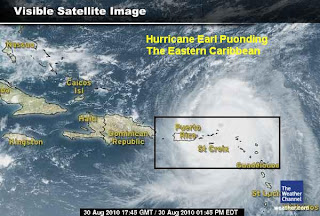

3:13pm Hazy, hot and humid conditions prevail all over the Northeastern United States. Temperatures are soaring well in to the 90's up and down the east coast from Bangor, Maine to Baltimore, Maryland. The high heat is attributed to a strong High Pressure System at the upper levels of the atmosphere stationed right over the eastern third of the nation. The heat wave will continue through Thursday before a rather strong cold front moves in from the west and drives this dome of High Pressure out to sea. The cold front is expected to usher in much cooler and more pleasant temperatures in to the Northeast in time for Labor Day weekend. In addition, this frontal boundary will be pivotal in determining the exact track of Hurricane Earl. As of 2:00pm eastern time the National Hurricane Center has tracked Earl approximately 120 nautical miles to the north of the Dominican Republic moving towards the west north west with a forward speed of 13 miles per hour. Maximum sustained wind have been recorded at 135 miles per hour making Hurricane Earl a powerful Category 4 storm. The current forecast brings the center of the storm off shore right along the east coast. NCEP forecast models suggest that Hurricane Earl will pick up froward momentum and zip northward into the Canadian province of Nova Scottia. Between now and then residents along the eastern seaboard need to keep a watchful eye on the unfolding situation; there is a chance that Hurricane Earl will make land fall over the east coast late this week Thursday through Friday. A strong cold front is expected to plow through the region. The strong jet stream behind this cold front is forecast to steer Hurricane Earl to the north and then eventually to the north east away from land sparing the east coast from the worst of Hurricane Earl; however, if this cold front moves slower than anticipated the High Pressure system that is currently producing the heat wave over the Northeast will steer Hurricane Earl closer to the coast and potentially bring it right on shore in a worst case scenario situation. If the worst case scenario transpires we could be dealing with a historic life changing event affecting millions of people along the densely populated Northeast. Conversely, if the upper level winds steer Earl away from the coast the Northeast will be spared from the brunt of the storm, regardless of what transpires we will still have to deal with high swells potentially 20 feet or better, significant beach erosion and coastal flooding through out the Labor Day weekend. At this moment Hurricane Earl is not expected to make a land fall in the United States; however, the exact track of this storm is still uncertain. The weather is very dynamic and a forecast can change with out notice, it would not be a bad idea to start preparing now for a worst case scenario. Have and emergency plan for evacuating.









